Taking The Coast Guard Mission To New Heights
by PA1 John Edwards, USCG Public Affairs Detachment Atlantic
City, special to ANN
(Editor's Note: The following report
provides an interesting, and different, perspective on security
matters in the Washington DC ADIZ... from the point-of-view of
those tasked with intercepting suspicious aircraft.)
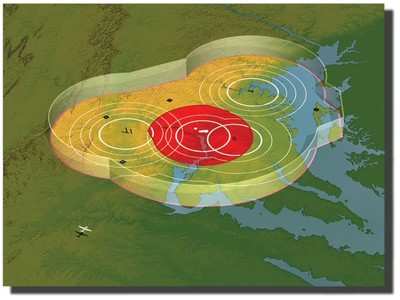
A helicopter, flying low and fast over the nation's capital,
changes its direction with surgical precision. The crew aboard
scan's the skies for their target. They are in pursuit of an
aircraft that has entered the restricted airspace over Washington,
DC. Their mission: interception.
Although it may sound like a scene from a movie, it is in fact
just another day on the job for crewmembers from Coast Guard Air
Station Atlantic City, NJ, who have recently been tasked with
conducting the Coast Guard's National Capital Region (NCR) air
defense mission. The bright orange colored helicopters that are so
common to coastal community residents and beachgoers across the
nation are now becoming a familiar sight in the skies over DC.
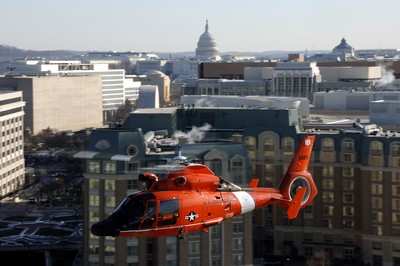
In a small ceremony held on Sept. 25, 2006, the Coast Guard
officially assumed responsibility for the Rotary Wing Air Intercept
(RWAI) mission from Customs and Border Protection.
"The Coast Guard's unique authorities and competencies as both a
military service and a federal law enforcement agency enable us to
assume permanent responsibility for executing the vital mission of
protecting the National Capital Region airspace for the Department
of Homeland Security in support of NORAD's multi-layered air
defense mission," said Admiral Thad W. Allen, commandant, US Coast
Guard.
Part of that multi-layered air defense mission has the Coast
Guard working directly under the direction of the North American
Aerospace Defense Command (NORAD) and partnering with other
federal, state and local agencies to protect critical
infrastructure and personnel. "We work alongside countless
Department of Defense and Department of Homeland Security assets to
provide safety and security to not only the federal government and
entities within Washington DC, but its citizens as well," said Lt.
Zach Mathews, pilot at Air Station Atlantic City. "This mission
also protects the pilots of general aviation aircraft who may have
inadvertently flown into the ADIZ whether due to mechanical or
electronic malfunction or by simple confusion," he said.
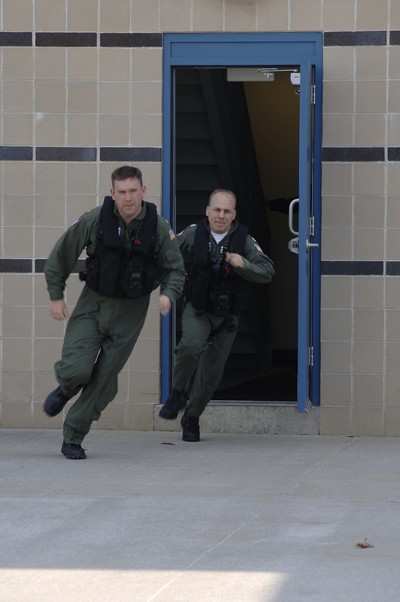
In order for the pilots and crew of the air station to
accommodate this full time mission into their already busy
schedules of search and rescue and law enforcement, the unit has
been outfitted with four additional HH65-C Dolphin helicopters on
top of its previous total of six and has increased its permanent
party staff from 80 billets to 160. Although the increase is
critical to mission success, the personnel at the air station face
challenges resulting from an increased mission load.
"The strain from going from 80 to 160 people in the hangar
requires that additional training flights must be scheduled in
order to keep these folks current with there semi-annual minimums,"
said Mathews. Crews must perform a set number of flight maneuvers,
approaches to the water, rescue hoists and swimmer deployments to
maintain their flight ready status. The RWAI training is now a part
of that mandatory semi-annual minimum.
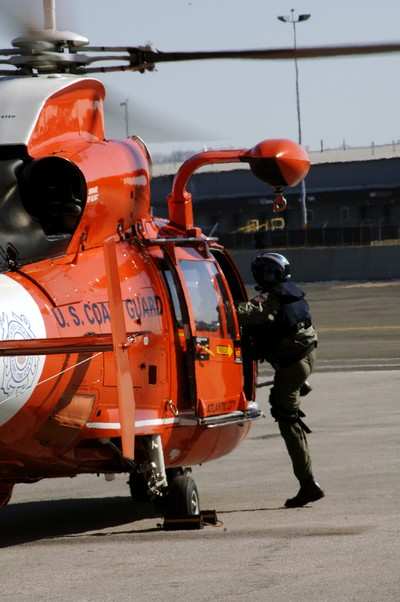
RWAI training is held weekly at the air station with the help of
the Coast Guard Auxiliary. Members of the Auxiliary help Coast
Guard air and boat crews all across the country train every day for
optimal mission readiness, and this is no exception. Auxiliary
pilots' volunteer their time and their aircraft for these air
intercept drills in order to help improve the pilot's response
times and to give them a moving target on which to hone their
flight interception techniques. The techniques used in interception
are taught to the pilots by instructors from the Coast Guard
Aviation Training Center (ATC) in Mobile, AL.
For the last three years, ATC Mobile has conducted intercept
training at its facility for Coast Guard pilots. Training consists
of learning how to intercept targets-of-interest at night using
night vision goggles and classes on intercept terminology and
missions. Additionally, pilots must learn and practice techniques
that place them extraordinarily close to other aircraft.
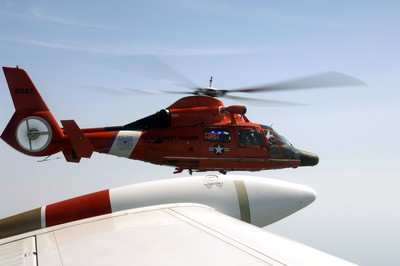
"The mission is so unique that we actually operate under a
Federal Aviation Administration waiver because we get so close to
the other aircraft," said Lt. Jeff Graham, RWAI instructor at ATC
Mobile.
The focus of this intensive training is to get to the target as
quickly as possible. "RWAI flights focus on how to get the aircraft
off the ground, up to altitude and to the target as expeditiously
as possible," said Graham. "It focuses specifically on launch
procedures, vectors and how to execute the appropriate intercept
maneuver depending on the target's position and speed," he
said.
The training provided by ATC Mobile has been utilized prior to
the full time duty of the NCR air defense mission. Coast Guard
pilots have participated in intercept ready missions such as the
2006 Superbowl, the Republican and Democratic National Conventions,
the G-8 Summit and in support of space shuttle launches.
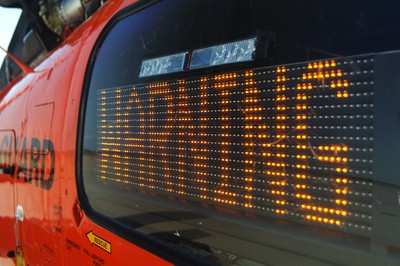
"The primary objective of any interception is to determine
intent," said Cmdr. Jacob Brown, NCR operations officer. "If they
will listen to us and are compliant, we can turn them away from the
DC area and they would no longer be a threat. If they are going out
of their way to not listen to us, they may have ill intent and it's
our job to determine that," he said.
To determine the intent of the targeted aircraft, air crews use
various methods of communication. "The primary means of
communication is going to be the lighted sign board that gives
specific directions to the pilots of the aircraft," Brown said. "We
will try and raise them on the radio at 121.5 MHZ and we also use
International Civil Aviation Organization signals like rocking the
wings or flashing our navigation lights," he said. "Using these
communication tools is going to be a big part of determining if
they are compliant."
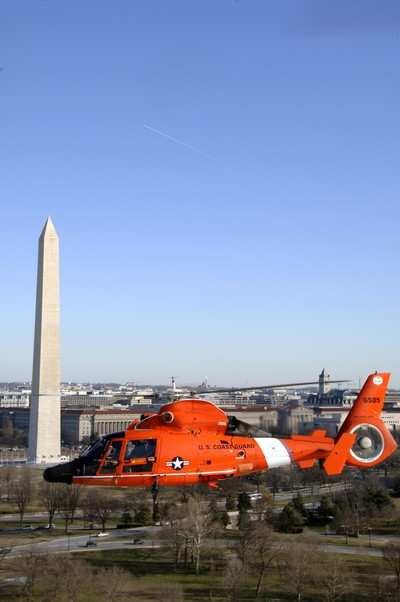
By incorporating intensive training and the Coast Guard's core
mission to protect the citizens of the United States, the NCR air
defense mission is a natural fit. As the face of the world changes,
so too must the Coast Guard change in order to meet today's
challenges. Known mostly as guardians of the sea, the public
recognizes the images of the bright orange helicopters saving the
lives of helpless mariners, but now as the citizens of DC. look to
the sky, they will see those same guardians taking their mission to
new heights.
(Photos courtesy of PA1 John Edwards)
 ANN's Daily Aero-Linx (05.06.25)
ANN's Daily Aero-Linx (05.06.25) ANN's Daily Aero-Term (05.06.25): Ultrahigh Frequency (UHF)
ANN's Daily Aero-Term (05.06.25): Ultrahigh Frequency (UHF) ANN FAQ: Q&A 101
ANN FAQ: Q&A 101 Classic Aero-TV: Virtual Reality Painting--PPG Leverages Technology for Training
Classic Aero-TV: Virtual Reality Painting--PPG Leverages Technology for Training Airborne 05.02.25: Joby Crewed Milestone, Diamond Club, Canadian Pilot Insurance
Airborne 05.02.25: Joby Crewed Milestone, Diamond Club, Canadian Pilot Insurance









